Marina do Brazil ermeged from WW2 as a winner, taking part in campaigns of Italy and the south atlantic route against German U-Boats, while shipyards were delivering a new set of brand new vessels. In fact during the war itself, three large destroyers were delivered, and six smaller started, all in the US-style, ASW trawlers, while receiving many sub-chasers. The cold war remotelly touched south america though, and in 1951 the country met a new “arms race” with its-arch rivals, Argentina and Chile, both acquiring the same Colossus class aircraft carriers (but Chile) and pairs of Brooklyn class cruisers, Fletcher-class destrouers and Balao/Tench class submarines. However in the 1970s the Brazilian navy started to change drastically. Exit the old destroyers, while new FRAM type entered service, and frigates, built in Brazil which always had a domestic shipbuilding industry. But origins were more varied, with British Vickers-Thornycroft frigates, German Type 209 submarines. Both the questions of a new aircraft carrier and the first nuclear attack submarines fed the 1990s transformation phase of Marinha do Brasil. An interim, the Naval Group Scorpène type Riachuelo class and local facilities to built more, as the first SSNs, the purchase of the former French Foch in 2000, and last year, of the ex HMS Ocean to replace her, still no ideal. Future will tell.
Timeframe of the Cold War for Brazil
The Brazilian Navy in 1945
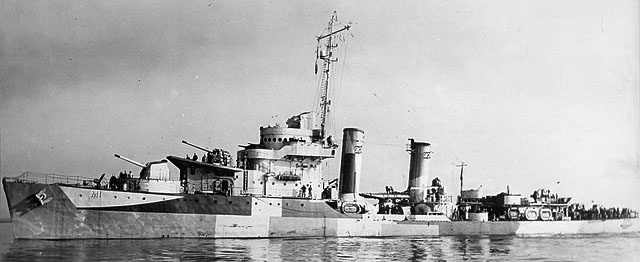
Marcilio Dias in 1945
Out of the Second World War, the Brazilian Navy acquired the long-desired parity with that of Argentina. Brazil supported the Allied war aguinst the Axis almost from the beginning: Allied planes patrolled the uth Atlantic from Brazilian airfields; convoys were sereened by Brazilian warships; and 25,000 Brazilian troops fought in Italy. It is not, therefore, surprising that, beginning in 1944, the United States began to trarisfer destroyer escorts to Brazil under Lend-Lease, Five years earlier, a proposed transfer of destroyers from the United States had created a furore in Argentina: the United States was accused of upsetting the balance of power and so the arrangement was cancelled. By the late 1940s, the theory of parity with Argentina had been established. The Brazilian Navy has been the Latin American trend-setter in warship acquisitions. This navy was the first to obtain the submarine, the dreadnought, and the aircraft carrier.
On V-Day, May 1945 (Brazil declared war on Germany, not Japan), The Marinha still counted a sizeable fleet, a large majority of which were small, but recent specialized vessels. The largest were basically obsolete at that stage:
–Minas Gerais class Battleships: The venerable Minas Gerais and Sao Paulo (1908) were the first dreadnoughts in (South) America, preceding even the US South Carolina class. They relaunched a naval arms race with Argentina and Chile, served in WW1 and WW2, but with little modernization, they were now permanently anchored prestige vessels, used for training cadets and guardships, with no plans of replacement. The Navy discarded them in 1951-53, both sold for BU.
–Rio Grande do Sul The 1908 British-designed cruiser was part of a two-ship Bahia class. Only the latter survived. Active in WW2, they patrolled from 1943 the South Atlantic, escorting convoys and even made a sweep in the Mediterranean to support the Italian campaign. Bahia was lost due to an accidental explosion in 1945, leaving her sister ship alone. Rio Grande became training ship until 1948, discarded and BU.
–Marcilio Dias class destroyers (1940) Diaz, Greenhalg and Mariz E Barros were fresh destroyers inspired by the Mahan class and used the same armament. They entered service in 1943-44 and stayed active until 1966 and 1972. See the WW2 section for more.
–Acre class destroyers (1942) Started during the war, but completed after, these six light destroyers (Acre, Ajuricaba, Amazonas, Apa, Araguary and Araguaya) were active until 1964-74.
–Babitonga class escort destroyers (1943): Ex US DET type (Canon class) transferred in late 1944-early 1945: Beberibe, Babitonga, Baependi, Bauru, Benevento, Bertioga, Bocaina and Bracui. They served in the pacific after the war and were discarded 1964-75.
–Henrique Diaz class trawlers (1942) These ASW trawlers built in Brazil on British plans (admiralty class) Barreto de Menezes, Felipe Camarao, Fernandes Vieira, Henrique Dias, Matias de Albuquerque and Vidal de Negreiros were resold to civilian service in 1951-60.
–Rio Pardo (1943) A Brazilian built 132 tons vessel, dedicated sub-chasers, diecarded 1974.
–Gioana class (1942) Eight 280 tons PC type sub-chasers (“G-class”), trasnferred during the war and discarded 1952-60
–Jacui class (1942)
Eight 95 tons SC types (“J class”), same, and all discarded in 1951.
–Humaita class submarines (1927) Old Italian oceanic type, in reserve 1945, discarded 1951.
–Tupi class submarines (1936) Three prewar coastal type 600 ton submarines, discarded 1960.
–Carioca class minelayers (1938) Cabedelo, Camaqua*, Camocin, Canadela, Caravelas, and Carioca, discarded 1960. *lost 1944
–River Gunboats Pernambuco (1910), Parnaiba (1937), Paraguacu (1938). Discarded 1948-72, Parnaiba preserved.
–Misc. ships TS Almirante Saldanha (1933), Ceara, submarine tender (1915). The first was discarded in 1992, the second in 1951?.

Parnaiba in the 1990s, the oldest Brazilian ship in service, now preserved.
Articles
- Minas Gerais aircraft carrier (1956)
- Cruiser Barroso (1951)
- Cruiser Tamandare (1951)
- Acre class destroyers (1945)
- Niteroi class Frigates (1974)
- Ihnauma class Frigate (1986)
- Tupi class submarines (1987)
- Cold War Brazilian patrol ships
The Brazilian Navy in 1960
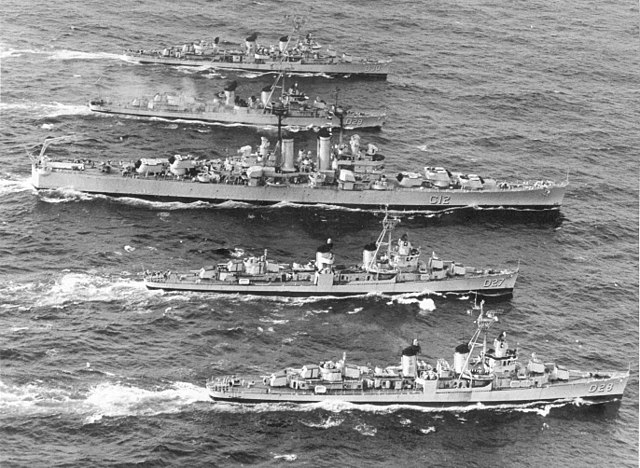
In 1956 Brazil purchased a Colossus class carrier, HMS Vengeance, from the Admiralty for $9m, and the ship, renamed Minas Gerais, was extensively modernised. The acquisition of the carrier caused a major inter-service struggle within Brazil. At issue was the control of the aircraft to be flown from Minas Gerais. From the completion of her modermisation until 1963, the carrier was planeless and neither President Jusecelino Kubitschek nor nis two successors were able to resolve the problem. In 1963 the Navy purchased six “T-28 trainers and four helicopters, but the Air Force, which was responsible for all military aircraft, refused to let the planes be assigned to the carrier.
Ultimately, numerous high-ranking Air Force and Nuvy officials resigned. The final decision was that fixed-wing aircraft operating from the carrier would be flown by the Air Force, und rotary-wing aircraft by the Navy. A naval air arm was created at last on 26 January 1965. The significance of this decision was that the Navy would not control attack aircraft and that the carrier would be exclusively an ASW platform. Thus, once again, the Argentine Navy, with Independencia and, later, 25 de Mayo would be the most powerful in the South Atlantic.
Brazil has taken the greatest advantage of bi-national shipbuilding agreements of any country in Latin America. Since independence in the early nineteenth century, Brazil’s struggle to develop a ship-building industry has been tenacious. One-third of the Brazilian fleet which participated in the War of the Triple Alliance (1864-70) was of indigenous construction, but from 1890 until the 1950s, Brazil tried to re-establish her shipbuilding industry. In December 1958, a major breakthrough ocurred as Ishikawajima-Harima Heavy Industries installed a yard in which skilled workmen were Brazilian, with a few Japanese filling technical and supervisory positions.
The lobster war (1961–1963)
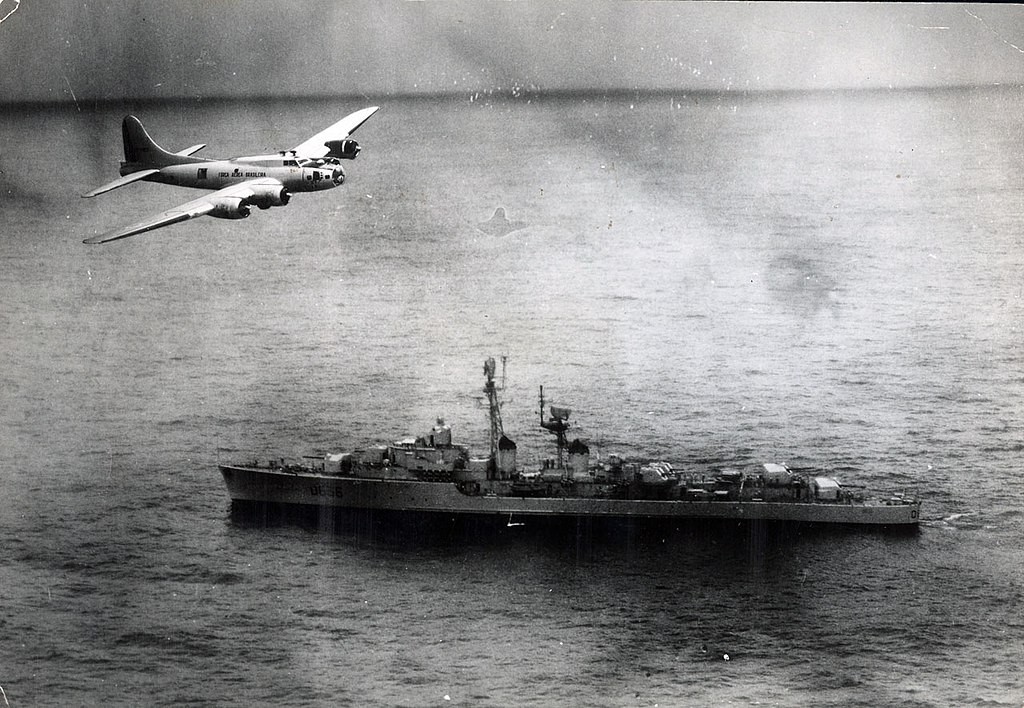
In 1961, groups of French fishermen operated profitably off the coast of Mauritania, and extended their fishing operations to the other side of the Atlantic Ocean, eventually settlong on a spot off the coast of Brazil, where lobsters were prolific in submerged ledges about 250–650 ft (76–198 m) deep. Local fishermen soon confronted these larger ships, after after horns noise and some mock-ramming, and bird’s names shoutouts decided to complain of this rampage to the state of Pernambuco.
The Government passed the concern to the admiralty, and Brazilian Admiral Arnoldo Toscano ordered two corvettes to the area. They supported the Brazilian fishermen’s claim and so both vessels demanded that the French boats retire to deeper water, notably due to their better equipments and larher size. It was argued, although these were international waters, the continental shelf belonged to Brazil. It was notably more fitting to the smaller Brazilian vessels.
However the French rejected this demand. They radioed a message relayed to the French government, asking to send a destroyer to escort them. This was intercepted and prompted the Brazilian Navy to ask the government a full naval mobilization. The Brazilian fleet was therefore put in a state of alert and all ships prepared.
The same day, Brazilian Foreign Minister Hermes Lima declared: “The attitude of France is inadmissible, and our government will not retreat. The lobster will not be caught.”. French President Charles de Gaulle meanwhile perceived this Brazilian interference and on 21 February greenlighted the departure of the 2,750-ton Tartu. However, he soon counter-manded the order to appease tension, while the matter went right to the Brazilian President João Goulart.
Her gave France 48 hours to withdraw the fishing vessels. Again, when apptoached by patrol boat, they refused to leave. The Brazilian Navy next made its move and seized the Cassiopée off of the Brazilian coast, on 2 January 1962. The presence of the Brazilian fleet met a standoff point, reaching a new height when the aircraft carrier Minas Gerais showed up and large bombers flew over the Tartu of the First Escort squadron, accompanied with the Aviso Paul Goffeny, repeatedly.
At the time there were discussions to mobilize the Offshore West African forces, comprising the Aircraft carrier Clemenceau and the Cruiser De Grasse.
In April 1963, both countries still bickered about the issue, France on 21 February 1963, sent from Toulon a task force headed by Clemenceau, escorted by De Grasse, Cassard, Jauréguiberry, Tartu (which came back in between), and the corvettes Le Picard, Le Gascon, L’Agenais, Le Béarnais, Le Vendéen plus the aviso Paul Goffeny and a the tanker. It was sent to the west coast of Africa to “show the flag” officially and doing exercises.
Knowing this, and a possible move westwards, the Brazilian Naval aviation started to deploy a search pattern above the continental shelf. At the time, Brazil deployed five B-17 Maritime Patrol bombers as well and a full squadron of twelve P-2 Neptune ASW patrollers, and a Squadron of four S-2 Trackers.
Meanwhile the ships made rotations and the Brazilians deployed around the Minas Gerais the Corvette Ipiranga, 6 Destroyers (Paraná, Babitonga, Pará, Acre, Araguari, Greenhalgh of the modernized Fletcher type), and two Cruisers, Almirante Barroso and Tamandaré of the Brooklyn (and sub St Louis) class. On both sides, if ships had radar, they were all conventionally armed, none had missiles.
Eventually the French stayed on West Africa and never came, de Gaulle deciding to have this affair resolved base don scientific ground and on the international scene. On 6 July 1966, the Administrative Tribunal of Rennes ruled that lobster could be assimilated as fish, swimming in the open sea and were no part of the continental shelf. Brazil claimed the latter at the contrary were fixed by their food source to the same location, therefore part of the continental shelf.
Admiral Paulo Moreira da Silva was at the time summoned as Brazil’s Navy expert in oceanography, and assisted a diplomatic committee, and only conceded to the French lobsters would be considered fish only when “leaping” on the seafloor.
Claims of two shipowners sighting compensation from France for their losses in the January–March fishing season 1969 had no right. The French Conseil d’État dismissed allegation of the French Government authorizing shipowners to send their vessels off the coast of Brazil as this was in the hands of the the masters of the vessels, not the shipowners. Without evidence of such authorization, claimed were rejected in last instance. For both parties, a settlement was found: The extension of Brazil’s territorial waters to a 200-nautical-mile zone was recoignised and validated internationally. Fishing authorization was however granted to French lobster fishing boats for 5 years, but with a portion retroceded to Brazilian lobster fishermen. The matter never resurfaced again.
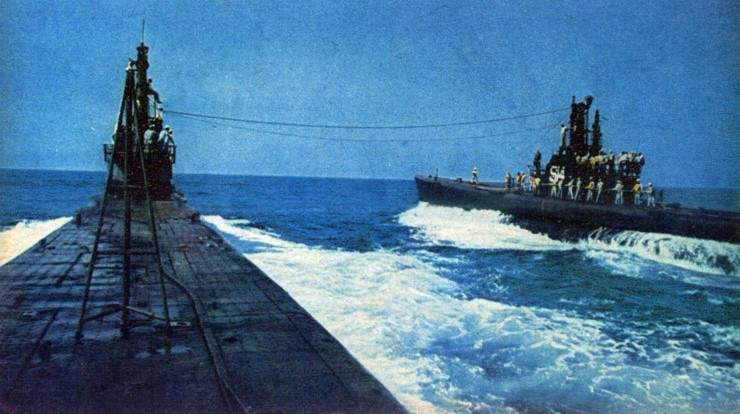
Humaita and Bahia making a refuelling underway at sea in the 1960s
1964 Coup d’état
Corporal punishment was officially abolished after the Revolta da Chibata (1910), working conditions & career plans were still lacking behind other navies in 1960. Fuelled by political discontent, and growing propularity of the president, a coup led by sailors and encouraged by some officers of the army was orchestrated in 1964, but failed. Purges were carried out later in all three arms with consequences for the Navy of the establishment of stricter condition to enlist, notably the traditional position of this branch concerning political loyalty.
The Brazilian Navy in 1990
Japan founded another new shipyard in Brazil by 1964. By 1974 it employed 3,250 persons, operated the two largest drydocks in Latin America, and had already constructed 426,906 grt. This, plus other maritime industries attracted into Brazil, provided the necessary industrial base for the bi-national agreement to construct frigates.
In 1970, Brazil and the British company Vosper Thornycroft agreed to construct six Mk 10 frigates, four of which were to be built in England and two in Brazil. In mid-1981 Brazil ordered a modified Mark 10 frigate to be built in Brazil. The frigate is classified as a training ship.
The newly established shipbuilding industry, plus the bi-national construction agreement, have thus allowed Brazil to begin to meet much of its own shipbuilding needs. In 1994 64,700 officers and men (12-month conscripts, including 14,600 marines) served with the Brazilian Navy; main bases are at Rio de Janeiro, Aratu, Belem, Natal, Ladario (river flotilla) and Sao Pedro (naval air arm) covering a 4655 mile coastline and the world’s longest river system. The active fleet totalled ninety-seven warships.
Brazilian Marines
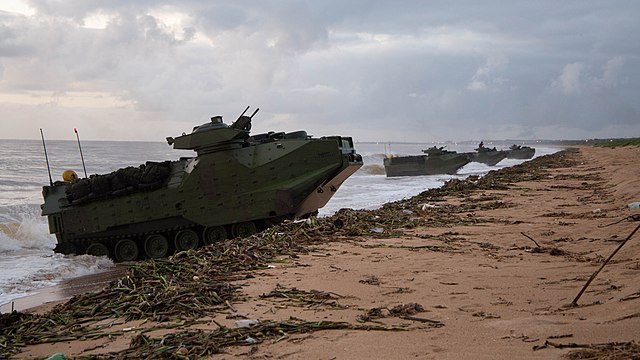
Brazilian Marines amhibious APC AAV-7A1. In addition, this corps operates the M113A1, Sk-105 Kurassier, Pirahna III augmented recentky by the ASTROS 2020 SPML (self propelled Missile launcher).
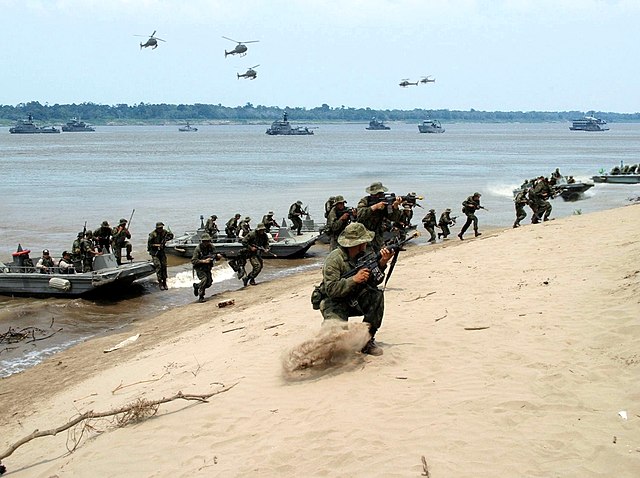
Brazilian Marines in riverine operation
Brazilian Air assets
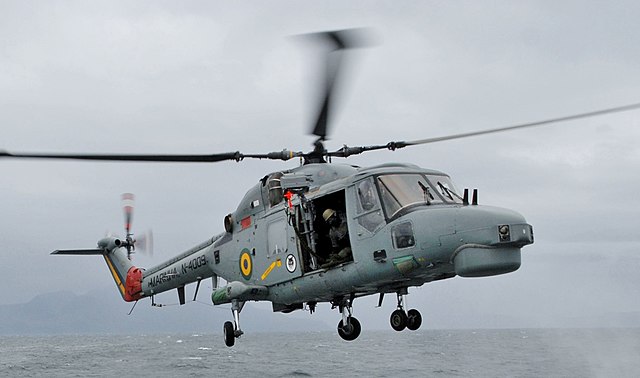
Westland Lynx.
The air park of the Brazilian Navy comprises mostly helicopters. Traditionally large airplanes were managed by the air force, like the B-17, P-2 Neptune and S-2 Trackers (but the A4 Skyhawk on Sao Paulo) while the Navy could operate helicopters: The Bell 206, Eurocopter AS350/AS355, AS332, EC725, Westland Lynx and Sikorsky SH-60. As of today, that’s a park of around 85 aircraft, including the Skyhawks.
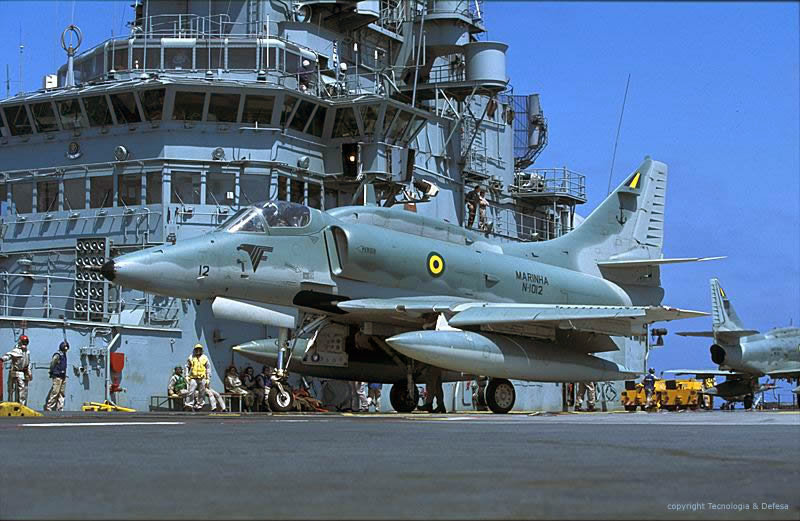
A Brazilian Skyhawk preparing to be launched onboard the Aircraft Carrier Sao Paulo
![]()
A Brazilian S-2E tracker landing on Minas Gerais, 1984
As of today and the future
The new Brazilian aircraft carrier

NAe São Paulo and USS Ronald Reagan in June 2004
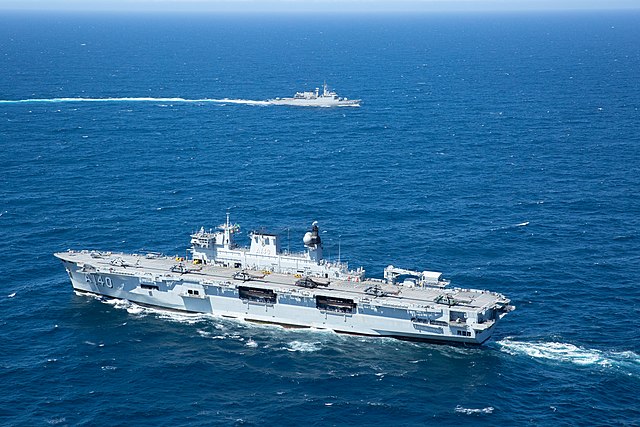
NAe Atlântico during Operation Poseidon in 2021
Thirty years after the end of the cold war, so three quarters of the actual lenght of it, the Brazilian Navy today offers the image of a well-rounded force, certainly the largest and most efficient of the continent. In 2020, there was 80,500 active personnel enlisted, and 16,000 for the Marine infantry alone. In 2012, the fleet comprised about 100 commissioned ships. Between 1996 and 2005 21 ships were discarded, and its flagship was the former Foch of the Clemenceau-class aircraft carrier, São Paulo (1959). She was discarded in 2017 notably due to two fires during overhauls and a odernization attempt in Brazil, leaving her gutted. Escalating repair costs aftter two fires curtailed this prospect. The ship is currently pending a decision to sell it to a scrapyard, but a French association tries to preserve her, without success so far.
In March 2014 the government announced a new carrier to enter service around 2029, but originally São Paulo (ex-Foch) was to be modernized as an interim measure. However the French company Naval Group (former DCNS) showcased the DEAC Aircraft Carrier project based on the Charles de Gaulle’s design but with an advanced conventional propulsion. It is way more modern than the original ship, with innovative platform stabilization systems, new magnetic catapults, or unmanned aerial vehicle integration. General Atomics was indeed included in the package for the Electromagnetic Aircraft Launch System (EMALS). Saab marketed also the Sea Gripen to replace the existing fleet of Skyhawks as the Air Force already operates the Gripen, in the land-based version. In between, the Brazilian Navy acquired the British former HMS Ocean, now reclassed as an helicopter carrier, PHM Atlântico. It’s not a CATOBAR carrier, the Brazilian has no Sea harrier, and possible replacements are not expected to to be started at least until 2025. A second life for the Charles de Gaulle when the new PAN-2 enters service is not planned before 2035 as scheduled and so very unlikely. It was also proposed to purchase a third conventional Queen Elisabeth class, to be built in UK.
Ambitious deterrent sub plan
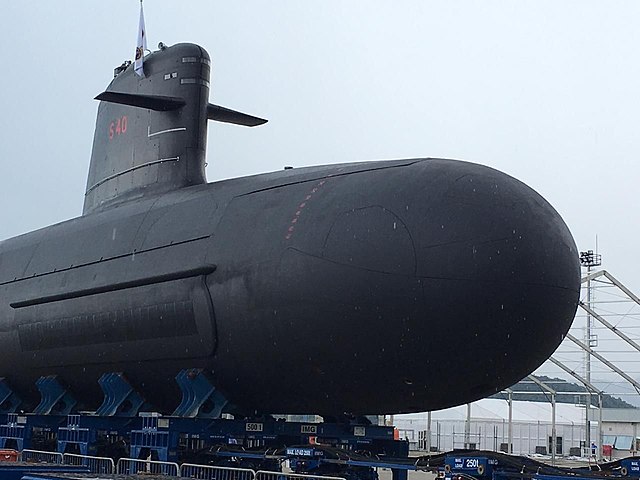
Submarine-wise, the Brazilian Navy operated four Tupi-class and one Tikuna-class Type 209 submarines (an imroved Tupi). Due to their basic design, Type 209, they were scheduled for upgrade by Lockheed Martin at $35 million, notably to receive MK 48 torpedo tubes. On 14 March 2008 however a radical upgrade came from the Naval Group four Scorpène-class submarines. In 2009 a purchase of four enlarged Scorpènes was signed for US$ 10 billion including a technology transfer agreement doubled by a French/Brazilian nuclear-powered submarine. Now it is known as the Riachuelo class, laid down at Cherbourg on 27 May 2010, jumboized at Sepetiba in late 2012 in Brazil. The other three are 100% built in Brazil and planned to be commissioned in 2020, 2021, and 2022. The first SSN Álvaro Alberto is under construction since 2018 but the scheduled launching of 2027 was postponed to 2032 to 2034 due to COVID and production issues. Three more are planned. Riachuelo (launched 14 December 2018) made her sea trials in September 2019 and is now operational. Itaguaí Construções Navais worked on the next, Humaitá, launched 11 December 2020 with an expected commission this year or 2022. The next, S42 Tonelero and S43 Angostura are expected in December 2021 and 2022 repectively.
Frigates & OPVs
In August 2008 the Navy accepted the corvette Barroso designed and built in Brazil for $263 million and in August 2012 requested four sister ships based modified to use a stealth design. The PROSUPER program FY2030 plan to acquire five new 6,000-ton frigates, five OPVs and a Logistics Support Vessel. By January 2012 BAE Systems was contracted for three PVs, now known as the Port of Spain-class corvettes, worth £133m. They wee initially buuilt for Trinidad and Tobago, cancelled in 2010. The last was commissioned in April 2013.
Read More/Sources
Anthony, Ian (1990). The Naval Arms Trade. Strategic issue papers. Oxford
Australian Naval Aviation Museum (ANAM) (1998). Flying Stations: a story of Australian naval aviation. St Leonards, NSW
Blackman, Raymond (ed.) (1968). Jane’s Fighting Ships, 1968-69 (71st ed.). Jane’s
Bishop, Chris; Chant, Christopher (2004). Aircraft carriers: the world’s greatest naval vessels and their aircraft. Grand Rapids
Cassells, Vic (2000). The Capital Ships: their battles and their badges. East Roseville, NSW: Simon & Schuster.
Donohue, Hector (October 1996). From Empire Defence to the Long Haul: post-war defence policy and its impact on naval force structure planning 1945-1955. Papers in Australian Maritime Affairs (No. 1). Canberra: Sea Power Centre.
Gordon, Lincoln (2001). Brazil’s Second Chance: En Route Toward the First World. Washington, D.C.: Brookings Institution Press
Hobbs, David (2005). “HMAS Sydney (III): a symbol of Australia’s growing maritime capability”. In Stevens, David; Reeve, John (eds.). The Navy and the Nation: the influence of the Navy on modern Australia. Corws Nest, NSW: Allen & Unwin.
Ireland, Bernard (2008) [2005]. The Illustrated Guide to Aircraft Carriers of the World. London, Anness Publishing.
Polmar, Norman (2001) [1993]. The Naval Institute Guide to the Ships and Aircraft of the U.S. Fleet (17th ed.). Annapolis.
Sharpe, Richard (ed.) (March 1996). Jane’s Fighting Ships, 1996-97 (99th ed.). Surrey: Jane’s Information Group.
Corless, Josh (1 June 1999). “The Brazilian Navy blazes a trail in the South Atlantic”. Jane’s Navy International.
English, Adrian J. (2002). “Focus on Latin American Navies”. Naval Forces. Bonn Mönch.
English, Adrian J. (1 May 1996). “Latin American Navies still treading water”. Jane’s Navy International. Jane’s
Brazil – Skyhawks begin flights from carrier”. Jane’s International Defence Review. Jane’s
“Carrier Aviation – Skyhawks set to land on Brazilian carrier”. Jane’s Navy International. Jane’s
Scott, Richard; Starr, Barbara (1 March 1999). “Carrier aviation at the crossroads”. Jane’s
Till, Geoffrey (April 2005). “Holding the Bridge in Troubled Times: The Cold War and the Navies of Europe”.
Official website
about the lobster war
PDF archive
navalnews.com
marinha.mil.br
naval.com.br
defesaaereanaval.com.br
About the siconta upgrade (br)
Inhauma class on naval-technology.com
Conway’s All the World’s Fighting Ships 1947–1995
Cicalesi, J.C. e Del Gaizo, Cesar: La Marina brasiliana. RiD magazine 2006
Saunders, Stephen. Jane’s Fighting Ships 2002–2003.
Detailed Nomenclature by class & dates
Laid down in November 1942 in Swan Hunter, HMS Vengeance was one of the first of the Collossus light fleet carriers built by Great Britain during WW2. On the stocks in the very harsh financial post war context, she found a customer quite rapidly. It was Brazil, which purchased her in 1956, but with a modernization adding 27m dollars over a purchase cost of $9m. This was done in Rotterdam over four years. The first Brazilian aircraft carrier was commissioned as NAeL Minas Gerais on 6 December 1960. She departed Rotterdam for Rio de Janeiro on 13 January 1961. Due to the duration of the refit she was only the second south american CV, after ARA Independencia in 1959.
Despite her small dimensions, her enlarged and reshaped flying deck was reinforced to operate jets up to 20,000 Ibs. and large helicopters. Apart the problem of not be allowied her own air park due to the resistance of the air force for years, she eventually operated six to seven ASW Grumman S2G tracker (flew by the air force as part of the compromise), eight SH3D Sea king, or 4-6 Agusta-Bell SH-3A, 2 Aerospace UH-13 Squirrel II, three UH-14 Super Puma.
Modifications comprised the construction of a lattice mast angled deck and new stealm catapult, mirrir-sight deck landing system, new fire control systems and radars, US electronics. A 2500 KW alternating current powerplant was also added, fed by four turbo-generators and a diesel. The hangar was modified as well, to 445 ft by 41 by 17 (135 x 15.8 x 5.3 m). Electronics comprised the SPG-34 radar for the quad mounts, two Mk 63 and a Mk 51 FCS, the SPS 12 air seach radar, SOS 8B, SPS-4, Raytheon 1402. During her major refit of 1976-80 she received the SPS-40 B radar and later the ZW-06, Scanter Mil. and Ferranti combat data system compatible with CAAIS ships. Last refit was in 1991, and she was decomm. on 16 October 2001 and Sold for scrap, as the new Sao Paulo (ex-Foch) entered service.
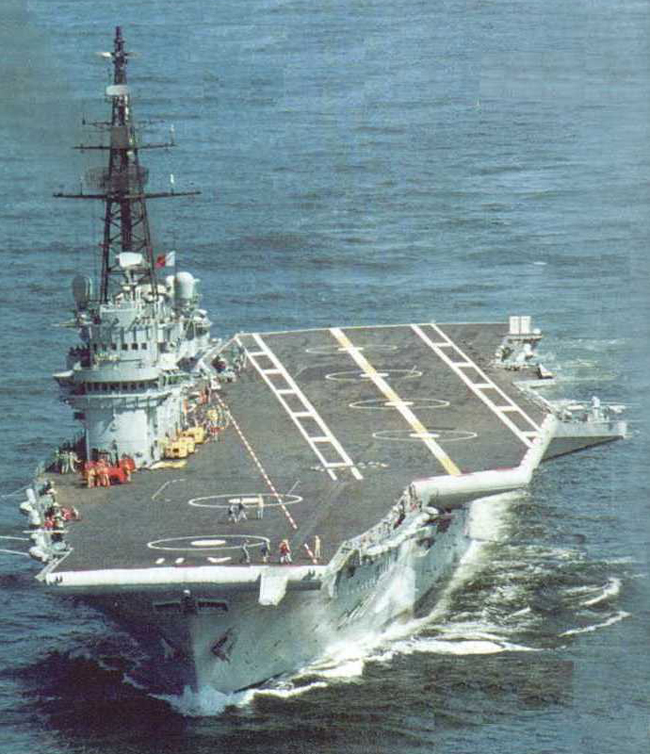

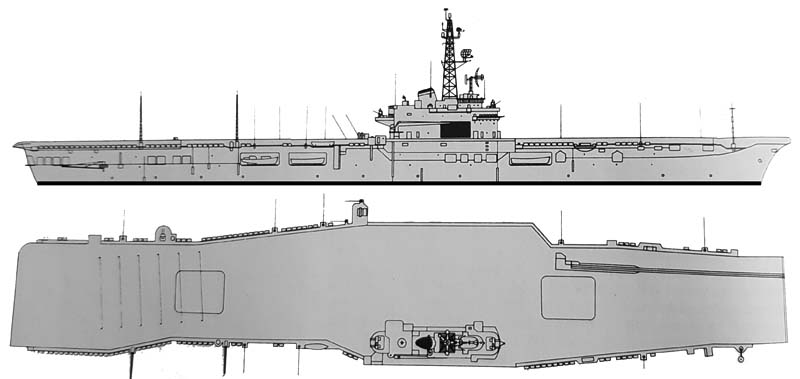
 Barroso class cruisers (1951)
Barroso class cruisers (1951)
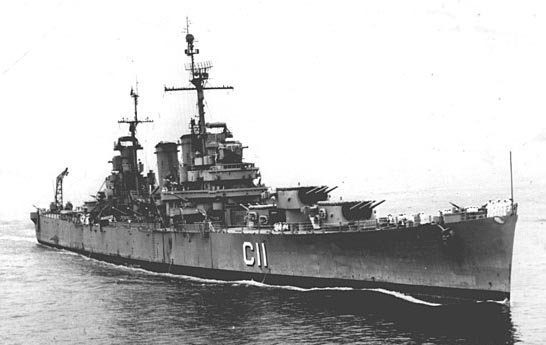
Built in Philadelphia as USS Philadelphia, and Newport News as USS St Louis, two Brooklyn class light cruiser was purchased on the stocks by Brazil in 1951. It was in January, and before Barroso (C11) was commissioned, she already had been modified: Bulges were added, and the conning tower was removed to improve stability. Before transfer, the mainmast derricks and catapults aft were removed. The hangar was kept, but to operate helicopters (up to four or two with spare parts). She kept her armament and sensors in stock conditions, with the single 5-in guns, twenty-eight 40 mm AA in seven quad mounts and twenty single 20 mm Oerlikon AA.
Tamandaré was commissioned later, in February 1952, with the same modifications of 1945, but differed by her more centralized superstructure aft, giving a better arc of fire, 5-in/38 in turrets on high bases, and small tripod abaft the aft funnel, same AA but only eight 20 mm guns. She had the same helicopter complement.
South America was a profitable market for its prewar Brooklyns: Outside Brazil, Argentina purchased aslo two, ARA Belgrano and Nueve de Julio, and Chile two, O’Higgins and Capitain Prat. The good old rivaly gave thirty more years of service to these ships… However, Tamandaré (C12) was really unique in what she was completely rebuilt and largely special. Her armament comprised the same twelve 6-in (152mm)/47 Mk 16, but four twin 5-in (127mm)/38 Mk 29, four quad 40mm/56 Mk 2, six twin 40mm/56 Mk 1, eight 20mm/70 Mk 10, and a single helicopter. They also differed by their electronic suite, modernized: Barroso had SK, SG, Mk 13, plus two fire control Mk 4 radars, while Tamandaré had the SK-2, SG, Mk 8, and two Mk 28 FC radars. They received later SK or SK-2 and SG radars, SPS-10 and SPS-12 radars, and were eventually decommissioned in 1978 and 1980 respectively, a remarkable 44 years since her keel was laid down for the latter.
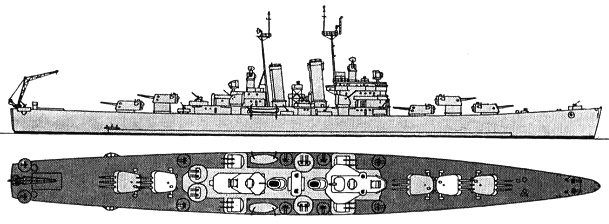
Tamandaré in 1965, note the differences with the other Brooklyns.
 Acre class Destroyers (1943)
Acre class Destroyers (1943)
Acre, Ajuricaba, Amazonas, Apa, Araguary, Araguaya
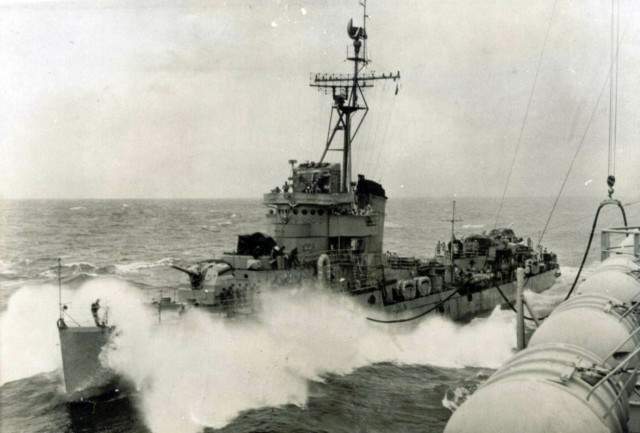
Acre class destroyers in the 1950s
Although covered already in the WW2 section, these small destroyers built on US wartime models at a reduced scale (“pocket Fletchers”) were buuuilt from 1943 at Arsenal de Marinha, Ilha das Cobras, Rio de Janeiro, and completed in 1949-51 and modernized in the 1960s. They also differed between themselves, as Acre, Ajuricaba had tow sets of General Electric geared steam turbines and 3 Babcock & Wilcox boilers while Amazonas, Apa, Araguari, Araguaya had Westinghouse turbines for 34,600-45,000 shp respectively. Top speed therefore varied between 33.5 and 36 kts. They carried 450 tons of oile for 6000 nm at 15kts. They were armed also differently: Acre had four 5-in (127mm)/38 Mk 30 and Mk 21, six 20mm/70 Mk 4, two triple 533mm TT banks, 2 DCT and 2 DCR. Ajuricaba had a twin 40mm/60 Mk 1, four 20mm/70 Mk 4 as Amazonas, Apa, Araguari, Araguaya, and their electronics suite comprised a SF-1 radar and QCR-1 sonar. After 1955 they were equipped with the following: Three 5-in/38, two twin 40mm/60 Mk 1, four 20mm/70 Mk 4, two triple 533mm TT, but ui exahnge of the third turret, eight DCT, two DCR and for electronics, SPS-4, SPS-10 radars and the QCR-1 sonar. They were discarded in 1964-74.
 Para class Destroyers (1959)
Para class Destroyers (1959)
Para, Maraibal (1959), Paranal, Pernambuco (1961), Piaui (1967), Santa Catarina (1968), Maranhao (1972)
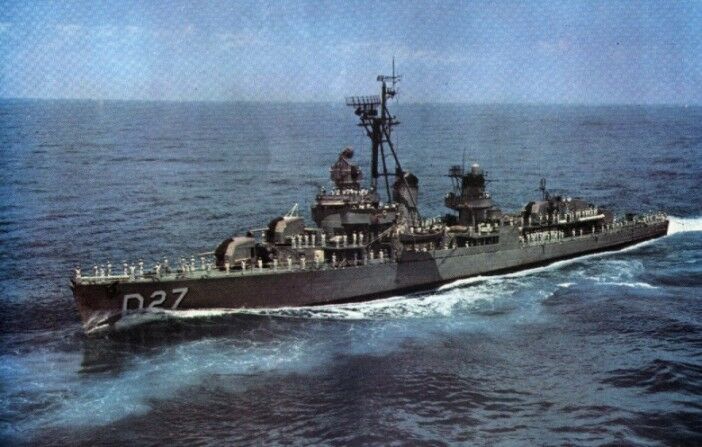
These Fletcher-class destroyers arrived by pairs, purchased on the stocks. The first pair in 1959, were earlier Fletcher production models with rounded bridges, the second pair had mass-produced simplified squarish bridges. They were the ex-Shields, Guest, Bennett, Francks, Knapp, Lewis Hancock, and Irwin respectively. Modenrized electronics when acquired, but Pernambuco (D 30) differed from the pack by having an armament of four single 5-in but three twin 76 mm AA, hedgehog and DC racks, the other having their five 5-in ten 40 mm Bofors in four twin and one single positions, same, and a triple 324 mm ASW TT. The twin mounts were provided to USS Knapp before transfer in 1961 and provided a much better AA capability. Modernization inclided a redesigned enclosed bridge, tripod main mast forward and additional antenna on the second funnel. They carried the ame electronics suite as US ships, SPS-6, SPS-10, Mk 25 radars, SQS-4, SQS-29 or SQS-32 sonar. They were decommissioned from 1978 to 1990 (Maranhao, the last acquired).
 Mato Grosso class Destroyers (1972)
Mato Grosso class Destroyers (1972)
Mato Grosso, Sergipe, Aagaos, Rio Grande do Norte, Espirito Santo
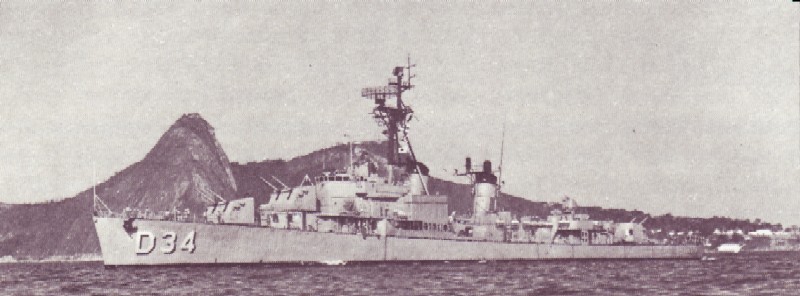
Same recipe here, but Allen M. Sumner class destroyers equipped with twin turrets and much larger. These were the ex USS Compton, James Mc. Owens, Bucks, Strong, and lowry respectively. They all received FRAM II modernization before transfer in 1972-73 but USS Mato Grosso. The latter instead received a quad short range Seacat SAM coupled with the Mk20 optical director. Sergipe and Saonto had a VDS sonar coupled with the standard SQS-29/32 sonar. Typical armament was therefore: Three triple 5-in (127mm)/38 Mk 38, two triple 324 Mk 32 TT banks, two 24-tubes Hedgehog ASWRL, one helicopter Westland Wasp. The radar suite comprised the SPS-10, SPS-29, Mk 25 radars, SQS-44 sonar, WLR-1, ULQ-6 ECM suites for the last, DD 38 Espiritu Santo and relatively simolar for the others. Still active in the 1990s, stricken 1990-96.
 Marcilio Diaz class Destroyers (1973)
Marcilio Diaz class Destroyers (1973)
Marcilio Diaz, Mariz E Barros
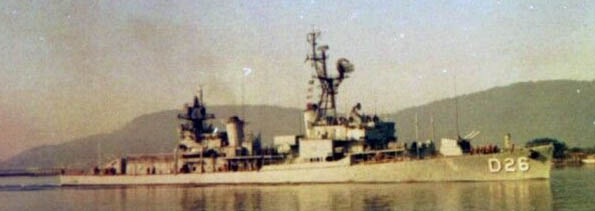

The last two US-built Brazilian WW2 destroyers were built in Consolidated, Orange, as Henry W Tucker and Brinckley Bass of the Gearing class. They were acquired also in 1973, but december, and received the pennants D25-26. They were both in FRAM I conversion state. Therefore they were armed as followed: Octuple ASROC ASuR (12 RUR-5), two twin 5-in (127mm)/38 Mk 38, two triple 324mm Mk 32 TT, Wasp helicopter. Their electronic equipment comprised the SPS-10, SPS-40, Mk 25 radars, SQS-23 sonar, WLR-1 and the ULQ-6 ECM suites. Stricken respectively in 1994 and 1997.
 Niterói class Frigates (1974)
Niterói class Frigates (1974)
Niterói, Defensora, Constituição, Liberal, Independênci, União, Brasil (F40-45, U27).
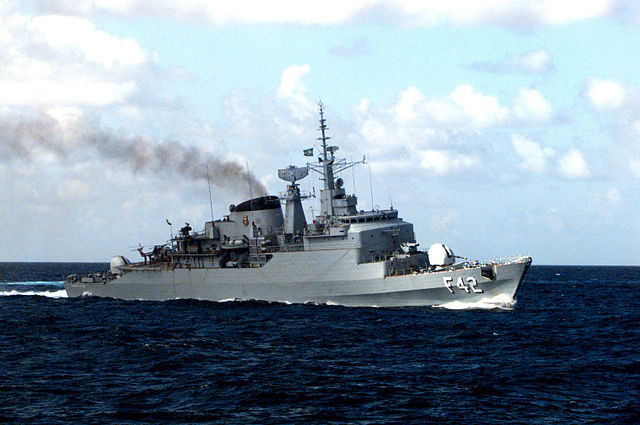
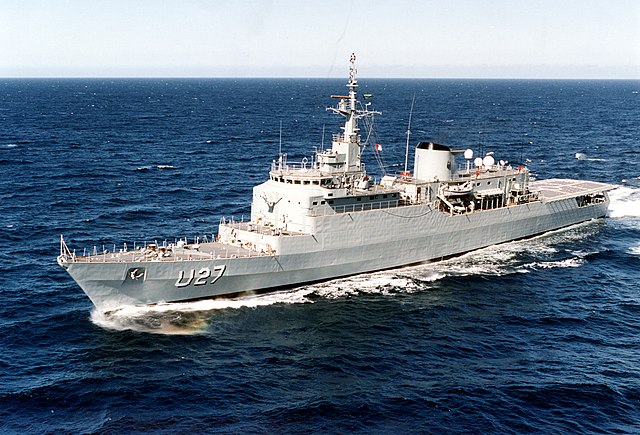
The Niterói class were designed and built by Vosper Thornycroft, and designed Mk 10. In the company catalog she was the largest on type offer over a wide array of products the shipyard created for foreign buyers and the Royal Navy itself, some even taking part in the Falklands war. Of these six vessels ordered two were in ASW configuration and two of the General Purpose or “GP” version. The remaining two ASW vessels were however built in Beazil under Vickers supervision as agreed, Arsenal da Marinha, in Rio de Janeiro. These late ASW ships had ther aft cannon replaced by an Ikara missile launcher, aft of the flight deck. It was later removed under ModFrag. The earlier GP vessels had a 4.5-inch (114 mm) gun instead. The seventh, called U27 Brasil, was built also in brazil but as a the main training unit of the class and not fitted with weapons or sensors.
The CODOG powerplant comprised two Rolls Royce Olympus gas turbines offering 56,000 hp (42,000 kW) combined, and four MTU diesel engines for 18,000 hp (13,000 kW) combined with a top speed of 30 knots and still 1300 nm radius at 28 knots. The original armament was modified with four Exocet canisters instead of the Ikara. Modenrization called for the replacement of the Seacat by an Aspide SAM, new M3 torpedoes, a Bofors Boroc ASWRL, and an Esquilo helicopter, Brazilian version of the AS 242 Squirrel. The electronics suite was also modernized to a RAN-20S air search radar, a Terma ‘Scanter Mil’ surface search radar, two RTN-30X fire control radars, a Saab EOS-400 optronic director and an upgraded EDO-610E hull mounted sonar, plus the SICONTA Mk 2 C3I system, Cutlass B1W ESM and ET/SQL-1 ECM system of counter-measures plus the same two 12-barrels 102 mm chaff launchers.
These ships were extensively modernized in 1996-2005 (‘ModFrag’ program), but delayed due to the lack of funds. Sea trials were also made intensively, followed by multiple corrections to to verify the new software, making the entire program slip from 2001 to 2005. The three earlier vessels are planned to be replaced by the new Tamandaré-class frigates, but a second modernization is planned for the last three, including the SICONTA MkII Mod. 1, developed by Akaer Engenharia in Brazil.


Niterói (ASW) and Constituição (GP), showing their armament differences as modernized.
Niterói class specifications (1980) |
|
| Dimensions | 129,2 x 13,5 x 5.5 m |
| Displacement | 3,355 t, 3,700 t FL |
| Crew | |
| Propulsion | 2 shafts gas turbines, 4 MTU diesels (CODOG) 18,000 hp |
| Speed | 30 knots (53 km/h; 35 mph) |
| Range | 1,300-5,300 nmi from 28-17 knots |
| Armament | 2 seacat, 1 Ikara/4.5 in, 4.5 in gun, 2x 40 mm AA, 375 mm Bofors ASWRL, 2×3 Mk32 TTs, DC rack, Lynx helicopter. |
| Sensors | AWS2, ZW-06, RTN-10X FSCR EDO-610/700E sonars, CAAIS, RDL-2/3 ESM, 2×12 chaff |
 Ihnaúma class Frigates (1986)
Ihnaúma class Frigates (1986)
V-30 Inhaúma, V-31 Jaceguai, V-32 Júlio de Noronha, V-33 Frontin

The Inhaúma were initially designed as small frigates by the Brazilian Naval Design Office, with assistance from Marine Technik in Germany. As built, standard displacement was just 1,700 tonnes, and up to 2,000 fully loaded. They measured 90/95.8 metres (314 ft 4 in) PPL/overall, 11.4 metres (37 ft 5 in) wide, with a 5.5 metres (18 ft 1 in) draft and were powered by a CODOG arrangement, with a GE LM 2500 gas turbine (20,500 kilowatts/27,500 hp) plus two MTU 16 V 396 TB 94 diesels giving 5,800 kW (7,800 bhp) on two shafts. Over modernizations, displacement went to 1,600/2,170 tonnes FL and with automation the crew went from 162 ratings plus 19 officers down to 145 and 15 officers.
They were missile ships with four Exocet surface-to-surface missiles canisters backed by a Mk 8 114 mm (4.5 in) gun forward. The twin Bofors 40 mm (1.6 in)/70 anti-aircraft mount was placed atop the aft superstructure. The triple bank Mk 32 324 mm (13 in) TTs were placed on either side of the superstructure for ASW Mk 46 acoustic torpedoes. There was also an helicopter pad (but no housing for it) operating a Westland Super Lynx. The initial design also planned a Vuclan Phalanx CIWS on the stern, but the design was already top heavy and this was dropped. A light SAM was considered as an alternative.
The sensors suite comprised a Plessey AWS-4 radar, a Kelvin Hughes Type 1007 and a navigational Selenia Orion RTN 10X radars, plus the Krupp Atlas ASO4 Mod 2 sonar. Electronic countermeasures comprised a IPqM/Elabra Defensor ET and a SLR-1X radar intercept system; plus the IPqM/Elabra ET SLQ-1 radar jammer. Two Plessey Shield chaff launchers are also added. Combat data management system is the Ferranti CAAIS 450 (Computer Aided Action Information System) combat data systems assisted by a SAAB EOS-400 fire control system. This made for a truly international design.
A fifth ship was later ordered on a modified design, Barroso (V-34) making a new sub-class. This improved Inhaúma-class is larger (1,814/2,390 tonnes, 4.5 metres (14 ft 9 in) longer at 103.4 m (339 ft 3 in) oa and 11.4 metres (37 ft 5 in) wide, to improve seakeeping, making for a larger engine room. Same CODOG arrangement and same complement of 145, same missile and main gun but with a Bofors 40 mm/70 SAK Sea Trinity CIWS, two 0.5 in HMGs, six ARES/DSAM SLT 324 mm Mk 46 TTs. New combat data system IPqM/Esca Siconta Mk III/Link YB. Saab/Combitech EOS-400 FCS, AESN RAN 20S surface radar, Terma Scanter 4100 navigational radar, AESN RTN 30-Y FC, EDO 977F sonar and same ECM. Current status: Three decommissioned 2014-2016, two in service.

Inhauma class specifications (1960) |
|
| Dimensions | 95.8 x 11.4 x 5.5 m |
| Displacement | 1,700t, 2,000 t FL |
| Crew | 145 |
| Propulsion | 2 shafts CODOG, 1 GS, 1 MTU diesels 27,500+7,600 hp |
| Speed | 27 knots (50 km/h; 31 mph) |
| Range | 4,000 nmi (7,400 km; 4,600 mi) 15 knots (28 km/h; 17 mph) |
| Armament | 4 exocet SSM, 1x 4.5 in, 2x 40 AA, 2×3 324 Mk32 TTs, 1 helicopter |
| Sensors | See notes |
 Para class Frigates (1989)
Para class Frigates (1989)
Para, Paraiba, Parana, Pernambuco
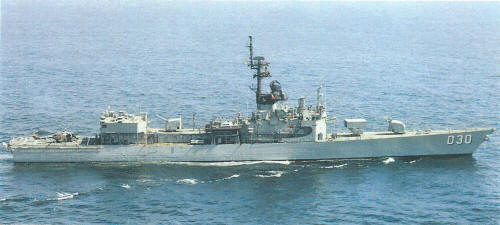
Leased Garcia class frigates (1964) for five years, starting in 1989 (comm. July-September), they arrived in December. They had an enlarged hangar. Para and Parana had their SQR 15 towed array sonar removed prior transfer, and they kept the now obsolete 5-in/38 WW2 vintage gun, but they had an ASROC. There were plans to even loan four ex-US Charles F. Adams missile destroyers but this was cancelled in 1993. They served the whole 1990s decade and were retired gradually, in 2002, 2004 and 2008 for Para.
 Humaita class submarines (1957)
Humaita class submarines (1957)
Humaita, Riachuelo
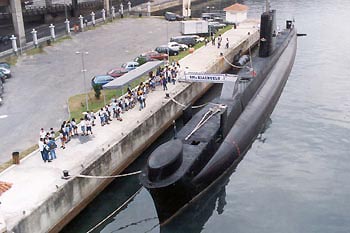

Riachuelo (S15) in a Museum
Humaitá was the ex-Muskallunge (S14), built in Electric Boat, Groton, USA in 4-12.1942 acquired in January 1957 and returned in March 1968. Riachuelo was the ex-Paddle (S15) also built in Groton in May-Dec.1942, acquired same time, stricken in June 1968. Both were Gato-class models modernized before transfer and at first under five-year loan under MDAP. Back in the US in 1967, USN Humaita was sunk as target.
 Guanabara class submarines (1963)
Guanabara class submarines (1963)
Rio Grande do Sul, Bahia, Guanabara, Amazonas

Guanabara was ex-Dogfish (S10) (launched 1945), stricken 10.1983, Rio Grande do Sul was ex-Sand Lance, ex-Ojanco, ex-Orca (S11) built in Portsmouth N Yd, USA, launched 25.6.1943 and transferred 9.1963, stricken 5.1972. Bahia was ex-Plaice (S12) built in Portsmouth N Yd, launched 15.11.1943, transferred also 9.1963, stricken 1.1973. Amazonas was ex-Greenfish, ex-Doncella. Launched 21.12.1945 and acquired 19.12.1973, stricken 10.1992.
Former USN Gato and Balao classes submarines. Guanabara was modernized under GUPPY II programme, Amazonas under GUPPY III programme. According to their types, the electronics suite varied between them: S11, 12, 14, 15: SS, ST, SV radars, WFA, JT sonars, APR-1 ECM suite – S10: SS, ST, SV radars, BQR-2, BQS-2, JT or SQR-3 sonars, APR-1 ECM suite, S16: BPS-1, BPS-4, BPS-5 radars, BQR-2, BQS-2, SQR-3, BQG-4 PUFFS sonars, BLR-1 ECM suite.
S16 Amazonas was the most powerful, having a modernized General Motors diesel-generators and 4 electric motors powerplant for 4610 and 5400 shp, 17.2 / 14.5 knts but S10 Guanabara was faster at 18/16 kts. It’s amazing that a Gato class could be in service until 1992, seeing both the end of WW2 and the cold war, but Amazonas was not preserved.
 Rio de Janeiro class submarines (1972)
Rio de Janeiro class submarines (1972)
Rio de Janeiro, Ceará, Goiás
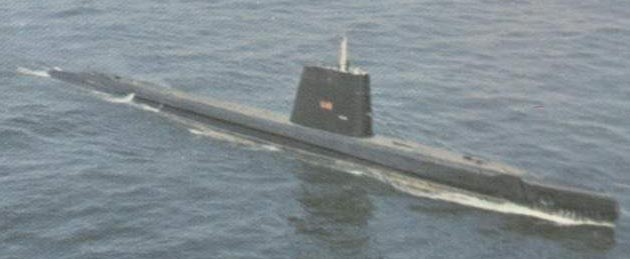
Former USN Tench classes submarines. Odax was already modernized GUPPY I. First four were modernized under GUPPY II programme, Goiás under GUPPY III programme. S-2A radar, BQR-2B, BQS-2, SQR-3 sonars, APR-1 ECM suite and for the next class SS-2A radar, BQR-2B, BQS-2, SQR-3, BQG-4 PUFFS sonars, BLR-1 ECM suite. They were decommissioned in 1978, stricken 1983, 1993 and 1987 respectively.
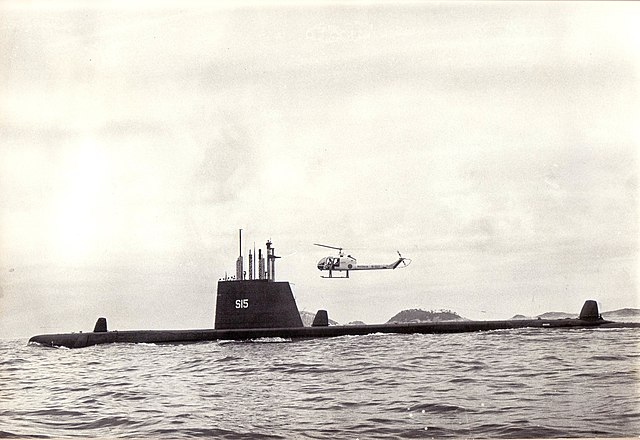
 Humaitá class submarines (1971)
Humaitá class submarines (1971)
Humaitá, Tonelero, Riachuelo S21-23.
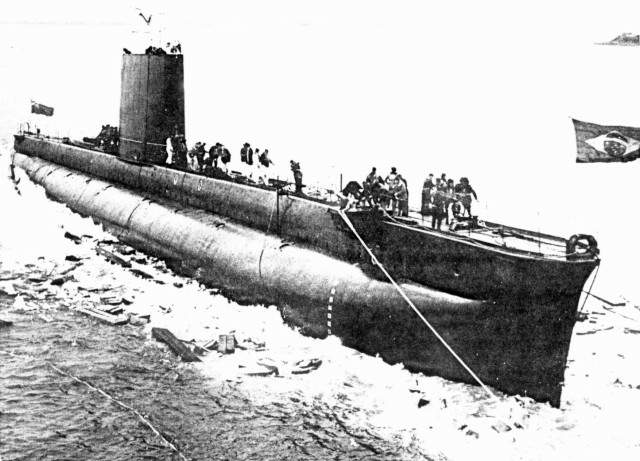
Laid down in UK as part of the Oberon class in 1970-73, launched 1971-75, commissioned 1973 and 1977-78. Tonelero’s completion was delayed by a serious fire, towed to Chatham’s drydock, the whole central 18m section removed and replaced, the whole rewired. This event pushed for a complete recabling of all Oberon boats under construction at the time. The Brazilian Oberons differed by having a fire-control system by Vickers system. This was later upgraded to support the British Mod 1 Tigerfish torpedo. They had eight standard 21-in TTs, 6 long forward (with 18 Mk 24 Tigerfish) and 2 short aft (four Mk 37 Mod. 2.). The electronic equipment suite included the type 1006 radar for surface navigation and detection of threats, and a type 187 and type 2007 sonars, plus the UA-4 ECM suite. They were Stricken in 1996-97.
 Tupi class submarines (1987)
Tupi class submarines (1987)
Tupi, Tamoio, Timbira, Tapajó


The first of the class was made in HDW, Kiel. Arsenal de Marinha do Rio de Janeiro built the three others. Laid down from 8.3.1985 to 6.3.1990; launched 28.4.1987 to 11.6.1998, completed 6.5.1989 to 16.11.1999. Close to the Type 209, they were propelled by four MTU 12V493 TY60 diesel-generators, a Siemens electric motor, 2400/5000 hp, 11/21.5 kts, 116 tons fuel oil, 11,000 nm at 8 knots surfaced and and via snorkel 400 nm at 4 kts.
It was armed by eight 533mm TT (bow, 16 Mk 24 Tigefish or Tp 62) and fitted with a Calypso III radar, the CSU-83/1 (DSQS-21) sonar suite, FAS-3, PRS-3/15 sonars, the DR 3000U ECM suite, and KAFS A10 CCS. The fourth, Tikuna (S-34) was a modified Type 209/1400. And additional fifth was a modified Type 209/1400 called Tapuia (S-35), cancelled. All were modernized with new combat systems capable of using the Mk.48 torpedoes.
(To be continued)


 Latest Facebook Entry -
Latest Facebook Entry -  X(Tweeter) Naval Encyclopedia's deck archive
X(Tweeter) Naval Encyclopedia's deck archive Instagram (@navalencyc)
Instagram (@navalencyc)





 French Navy
French Navy Royal Navy
Royal Navy Russian Navy
Russian Navy Armada Espanola
Armada Espanola Austrian Navy
Austrian Navy K.u.K. Kriegsmarine
K.u.K. Kriegsmarine Dansk Marine
Dansk Marine Nautiko Hellenon
Nautiko Hellenon Koninklije Marine 1870
Koninklije Marine 1870 Marinha do Brasil
Marinha do Brasil Osmanlı Donanması
Osmanlı Donanması Marina Do Peru
Marina Do Peru Marinha do Portugal
Marinha do Portugal Regia Marina 1870
Regia Marina 1870 Nihhon Kaigun 1870
Nihhon Kaigun 1870 Preußische Marine 1870
Preußische Marine 1870 Russkiy Flot 1870
Russkiy Flot 1870 Svenska marinen
Svenska marinen Søværnet
Søværnet Union Navy
Union Navy Confederate Navy
Confederate Navy Armada de Argentina
Armada de Argentina Imperial Chinese Navy
Imperial Chinese Navy Marinha do Portugal
Marinha do Portugal Mexico
Mexico Kaiserliche Marine
Kaiserliche Marine 1898 US Navy
1898 US Navy Sovietskiy Flot
Sovietskiy Flot Royal Canadian Navy
Royal Canadian Navy Royal Australian Navy
Royal Australian Navy RNZN Fleet
RNZN Fleet Chinese Navy 1937
Chinese Navy 1937 Kriegsmarine
Kriegsmarine Chilean Navy
Chilean Navy Danish Navy
Danish Navy Finnish Navy
Finnish Navy Hellenic Navy
Hellenic Navy Polish Navy
Polish Navy Romanian Navy
Romanian Navy Turkish Navy
Turkish Navy Royal Yugoslav Navy
Royal Yugoslav Navy Royal Thai Navy
Royal Thai Navy Minor Navies
Minor Navies Albania
Albania Austria
Austria Belgium
Belgium Columbia
Columbia Costa Rica
Costa Rica Cuba
Cuba Czechoslovakia
Czechoslovakia Dominican Republic
Dominican Republic Haiti
Haiti Hungary
Hungary Honduras
Honduras Estonia
Estonia Iceland
Iceland Eire
Eire Equador
Equador Iran
Iran Iraq
Iraq Latvia
Latvia Liberia
Liberia Lithuania
Lithuania Mandchukuo
Mandchukuo Morocco
Morocco Nicaragua
Nicaragua Persia
Persia San Salvador
San Salvador Sarawak
Sarawak Uruguay
Uruguay Venezuela
Venezuela Zanzibar
Zanzibar Warsaw Pact Navies
Warsaw Pact Navies Bulgaria
Bulgaria Hungary
Hungary

 Bundesmarine
Bundesmarine Dutch Navy
Dutch Navy Hellenic Navy
Hellenic Navy Marina Militare
Marina Militare Yugoslav Navy
Yugoslav Navy Chinese Navy
Chinese Navy Indian Navy
Indian Navy Indonesian Navy
Indonesian Navy JMSDF
JMSDF North Korean Navy
North Korean Navy Pakistani Navy
Pakistani Navy Philippines Navy
Philippines Navy ROKN
ROKN Rep. of Singapore Navy
Rep. of Singapore Navy Taiwanese Navy
Taiwanese Navy IDF Navy
IDF Navy Saudi Navy
Saudi Navy Royal New Zealand Navy
Royal New Zealand Navy Egyptian Navy
Egyptian Navy South African Navy
South African Navy






























 Ukrainian Navy
Ukrainian Navy dbodesign
dbodesign